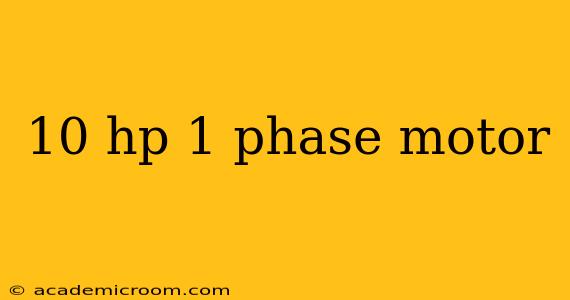Finding the right motor for your application can be challenging, especially when dealing with higher horsepower requirements like a 10 HP 1-phase motor. This guide will delve into the specifics of these motors, addressing common questions and providing valuable information for making an informed decision. We'll cover everything from their applications and advantages to potential drawbacks and considerations for installation.
What are the applications of a 10 HP 1-phase motor?
10 HP 1-phase motors are powerful enough for a variety of demanding applications. They are commonly used in industrial settings where a three-phase power supply isn't readily available or practical. Specific applications include:
- Heavy-duty pumps: These motors are ideal for powering large pumps used in agriculture, construction, or industrial processes requiring significant fluid movement.
- Large compressors: Applications requiring high air pressure, such as some industrial air tools or specialized manufacturing processes.
- Industrial machinery: Various pieces of equipment in workshops, factories, and processing plants might utilize these powerful motors for operation. Examples could include conveyors, mixers, or specialized machinery.
- Agricultural equipment: Some large agricultural implements, like certain types of feed mixers or grain processing machines, require this level of power.
What are the advantages of using a 10 HP 1-phase motor?
The primary advantage of a 10 HP 1-phase motor is its compatibility with standard single-phase power supplies. This eliminates the need for costly three-phase electrical installations, making it a more accessible option in many situations. Other advantages include:
- Simplicity: Generally simpler to install and maintain compared to three-phase equivalents.
- Cost-effectiveness (in certain situations): While the initial cost might be higher than smaller 1-phase motors, the elimination of three-phase infrastructure costs can lead to overall savings in some cases.
- Wide Availability: Although less common than smaller 1-phase motors, several manufacturers produce 10 HP units.
What are the disadvantages of using a 10 HP 1-phase motor?
Despite their advantages, 10 HP 1-phase motors also have some drawbacks:
- Higher initial cost: Compared to similar horsepower three-phase motors, the price point will usually be higher.
- Lower efficiency: Typically less efficient than three-phase motors, resulting in higher energy consumption and operating costs.
- Limited availability: Finding a suitable motor for a specific application might require more research and potentially longer lead times.
- Potential for overheating: The higher power output in a single-phase configuration can lead to increased heat generation, necessitating adequate cooling systems.
How much does a 10 HP 1-phase motor cost?
The cost of a 10 HP 1-phase motor varies greatly depending on the manufacturer, specific features (e.g., capacitor type, speed control options), and the vendor. Prices can range significantly, so it's crucial to obtain quotes from multiple suppliers before making a purchase decision.
Where can I buy a 10 HP 1-phase motor?
10 HP 1-phase motors can be purchased from various industrial motor suppliers, both online and in brick-and-mortar stores. It is highly recommended to consult with a motor specialist to ensure you are selecting the correct motor for your specific application and to discuss available options.
What type of capacitor is needed for a 10 HP 1-phase motor?
The type of capacitor required will depend on the specific motor design. Some 10 HP 1-phase motors utilize a permanent capacitor, while others might have a dual capacitor system (start and run capacitors). Consult the motor's specifications for the correct capacitor type and value. Incorrect capacitor selection can lead to motor damage or inefficient operation.
How efficient is a 10 HP 1-phase motor?
The efficiency of a 10 HP 1-phase motor varies depending on the manufacturer and motor design. Generally, they are less efficient than three-phase counterparts. Always check the motor's specifications for its efficiency rating (often expressed as a percentage). Look for motors with higher efficiency ratings to minimize energy consumption and operating costs.
This guide provides a comprehensive overview of 10 HP 1-phase motors. Remember to always consult with a qualified electrician or motor specialist before installing or operating any high-power electrical equipment. The information provided here is for informational purposes and should not be considered professional advice.
